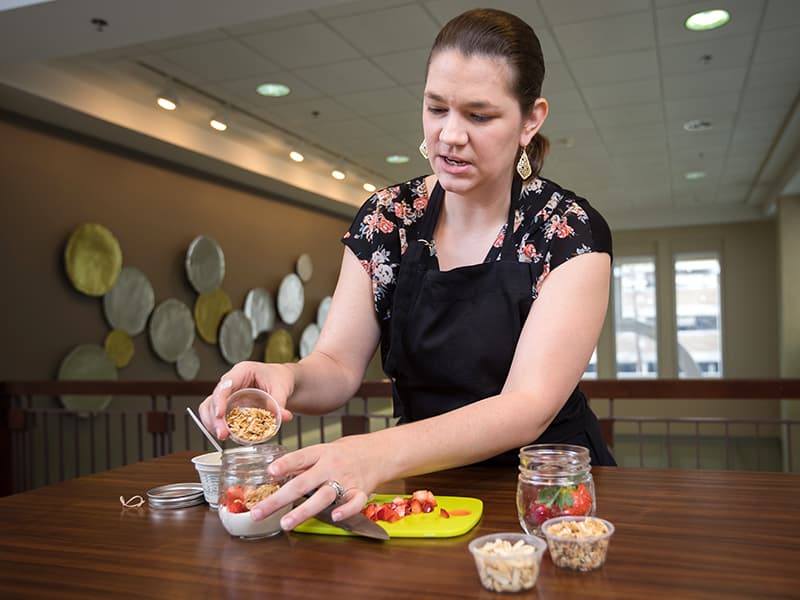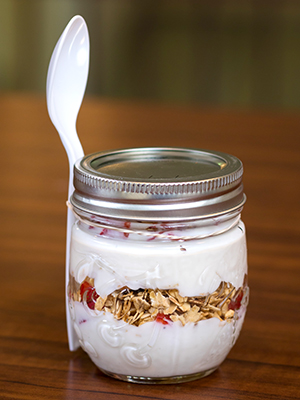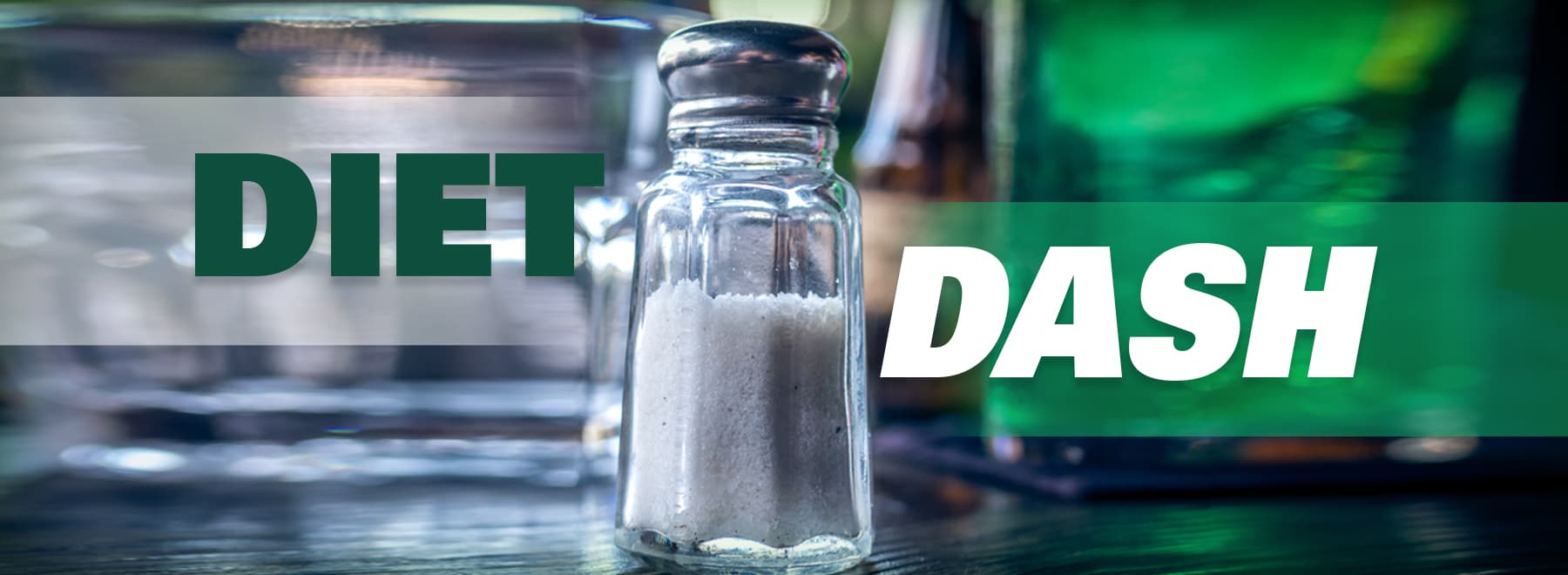UMMC experts weigh in on popular 'common sense' eating plan
Health guru Dr. Josie Bidwell said when she thinks of the popular DASH diet, she envisions someone dashing a shaker of salt over a meal rather than dousing the plate.
She’s not that far off.
The DASH, or Dietary Approaches to Stop Hypertension, diet is touted by health experts as most effective when it’s combined with eating less sodium. Translation: Don’t just eat a healthy diet, but look for ways to cut your salt intake.
For the eighth consecutive year, U.S. News and World Report has ranked DASH as “best diet overall” of nearly 40 it reviewed. DASH was developed by the National Institutes for Health and it has the potential to lower blood pressure as well or better than medications do.
“DASH is just good, basic, healthy nutrition choices,” said Bidwell, an associate professor of nursing at the University of Mississippi Medical Center who regularly whips up her own recipes featuring fresh ingredients and tasty seasonings.

Most people don’t know the DASH diet by that name, said Dr. Dan Jones, UMMC professor of medicine and director of clinical and population sciences at the Mississippi Center for Obesity Research. MCOR is based at UMMC.
“It’s not had a vendor, so to speak. It’s not had a marketing advocate,” Jones said. “But it’s very simple. It promotes a healthy eating pattern that focuses on fresh fruits and vegetables, low-fat dairy products and consumption of proteins low in saturated fats.”
DASH is a valid healthy eating plan because it’s not a come-and-go fad diet “that tells you, ‘Don’t eat grains’ or ‘Don’t eat dairy,’” Bidwell said. “Those type diets work, but they’re not necessarily the healthiest, and they’re not sustainable. That’s why they don’t score well nationally, and DASH does.”
Researchers came up with DASH to address high blood pressure, but they found it’s also a great tool for lowering blood cholesterol. The research comes through the NIH’s National Heart, Lung, and Blood Institute, or NHLBI.
“The consistent high rankings of DASH over the years bode well for the way the diet is received and adopted, not just by health professionals, but by the public at large,” Janet de Jesus, a registered dietitian and program officer at NHLBI’s Center for Translation Research and Implementation Science, told U.S. News and World Report. “This is especially gratifying now that new research underscores the significant blood-pressure-lowering effects of a reduced intake of sodium in combination with the DASH diet.”
Mississippi has the second-worst rate of hypertension in the nation, with about 42 percent of adults coping with high blood pressure, according to the State of Obesity, a project of Trust for America’s Health and the Robert Wood Johnson Foundation. Only West Virginia is worse, with 42.7 percent of adults with hypertension. High blood cholesterol can go hand in hand with hypertension, Bidwell said.
DASH is based on the consumption of more fruits and vegetables, more whole grains and less refined sugars found in things like sugary or carbonated drinks and snack cakes, Bidwell said. “It’s about eating low-fat or fat-free dairy, lean cuts of fish and poultry, and vegetable oils instead of saturated fats.”

The DASH diet takes on cholesterol by advocating eliminating or reducing foods that are high in fats. Saturated fats that are solid at room temperature – butter, shortening and coconut oil, for example – are calorie-dense but not nutrition-dense, Bidwell said.
And there’s a low-sodium version of the DASH diet that specifically calls for a minimal amount of salt and sodium, Jones said.
“I advocate that for my patients,” he said.
“Limiting red meat also will help with cholesterol and your weight modification,” Bidwell said. “Any time we can improve our weight patterns, we will see improvement in blood pressure. We need to use the least amount of processed items that we can.
“Eat fresh and frozen veggies, low-sodium canned vegetables and whole grains. Sodium intake is linked to high blood pressure, so lowering salt and calorie-dense foods help. And it’s not hard to do.”
You don’t need to get hung up on the diet’s name – unless it helps you focus on what you should and should not be eating, Bidwell said. Click here for examples of DASH breakfast, lunch and dinner menus.
“We may not call it the DASH diet. We call it healthy eating,” said Bidwell, who has discussed DASH on her “Healthy and Fit” radio show that broadcasts at 11 a.m. Mondays on Mississippi Public Radio’s “Southern Remedy” series. “When we’re talking about healthy lifestyles, we say eating plan, or eating pattern. That indicates to a patient that we’re asking you to commit to this for the long term, and not just right now.”
The word “diet” might make someone immediately think the idea is to lose weight, but that’s not necessarily so, Jones said.
“The DASH diet per se is not focused on weight management, but it’s a great tool. It gives you food lower in calories than other eating patterns.”
One strategy for delivering on DASH, according to Bidwell: Ease into it.

A yogurt, fruit and granola parfait is the perfect breakfast treat on the DASH diet.
“You need a plan,” she said. “The premise behind healthy eating is not hard, but how do we convert that to our daily life and our budget? What are the kids going to eat?”
If you drink two carbonated beverages a day, she said, resolve to go down to one and increase your water intake by a couple of glasses. From there, go to half a carbonated beverage, and up your water some more to compensate.
“Short, achievable goals help people to make a healthy choice, rather than a massive list of no more bread, no more rice. That’s too much,” Bidwell said. “If you’re eating one serving a day of fruit, let’s figure out how to add another serving. Maybe that could be buying some Cuties (mandarins) and throwing one in your lunch bag.”
Diets that have a name sometimes are comforting “because people think they give them instructions on what to do,” Bidwell said. “But what baffles me is when people say they have to eat something that’s on a diet, even though they don’t like it – that they’ll just have to force it down. Are you going to do that every day for the rest of your life?”
Jones believes the American public is not enthusiastic about new diet after new diet being touted in the media.
“Nutrition science is so complicated,” he said. “With our wonderful way of communicating on the Internet, there’s so much information. People remain confused. I’m not a proponent of promoting another ‘diet.’’’
He and Bidwell agree the health benefits are profound with a diet like DASH – by any name.
“It’s common-sense eating advice that I’ve been giving my patients for years,” Jones said.
Breakfast parfait
Bidwell used the following recipe during a recent DASH diet demonstration:
1 container (5.3 oz) nonfat blended vanilla greek yogurt
¼ cup granola
½ cup sliced strawberries (or fruit of your choice)
1 Tbsp slivered almonds
Empty 8 oz jar
Layer ½ of the yogurt, followed by ½ of the strawberries, granola, and almonds. Repeat layers. Enjoy at once, or add jar lid and spoon and store in your fridge for 1-2 days for a breakfast treat on the go.
Total calories 298
Total fat 6 g (0g saturated fat)
Total Carbohydrates 44 g
Dietary Fiber 5 g
Protein 20 g



